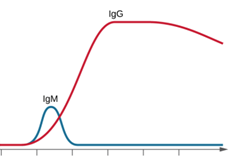Adaptive immunity is characterized by two distinct responses: the primary and secondary immune responses. Understanding these responses is crucial for grasping how the immune system protects the body against pathogens. The primary immune response occurs upon the first exposure to an antigen, leading to a slower and weaker immune reaction. During this initial phase, the body takes time to produce antibodies, primarily Immunoglobulin M (IgM), which is the first antibody class generated. This response can take several weeks, resulting in a relatively low concentration of antibodies in the bloodstream.
In contrast, the secondary immune response is triggered when the body encounters the same antigen again. This response is significantly faster and more robust, primarily due to the presence of memory B cells and memory T cells, which are formed during the primary response. These memory cells enable the immune system to recognize and respond to the antigen more effectively. In the secondary response, the body quickly produces a higher quantity of Immunoglobulin G (IgG), a more effective antibody, often within less than a week. This rapid response can eliminate the antigen before the individual even experiences symptoms of infection.
The differences between these two responses can be visualized in a graph where the x-axis represents time (in weeks) and the y-axis indicates antibody concentration in the blood serum. The primary response shows a gradual increase in IgM levels, while the secondary response demonstrates a swift rise in IgG levels, highlighting the efficiency of the immune system upon re-exposure to the same pathogen.
As the body encounters the same antigen multiple times, the immune response continues to improve, leading to even quicker and more effective responses with each subsequent exposure. This phenomenon underscores the importance of memory cells in adaptive immunity, as they are essential for mounting a strong defense against previously encountered pathogens.




